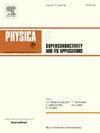Three-medium treatment of heat transfer in porous media and its application in CICC
IF 1
3区 物理与天体物理
Q4 PHYSICS, APPLIED
Physica C-superconductivity and Its Applications
Pub Date : 2025-02-20
DOI:10.1016/j.physc.2025.1354650
引用次数: 0
Abstract
In this article, we derive the multi-temperature macroscopic model suitable for the porous CICC structure by using the volume average method. A CICC porous structure usually consists of three phases: one moving fluid phase (typically liquid helium) and two solid phases (typically copper and superconducting alloy). With the assumption of the equal average temperatures of the two solid phases, we obtain a two-temperature macroscopic model. The relevant closure problems are derived and solved numerically for a JT-60SA CICC structure and a ITER-TFPS CICC structure to obtain the macroscopic parameters. The calculated internal heat transfer coefficients are consistent with the experiment results, indicating the accuracy of the proposed two-temperature model. From the proposed two-temperature model, the temperature difference between the fluid and solid phases can be evaluated under a given heat source, which helps to determine whether the one-temperature model can be applied, or the two-temperature model needs to be applied. Typically, the one-temperature model may be suitable for CICC under nominal operation conditions, and the multi-temperature model is necessary during quenching process.
多孔介质换热的三介质处理及其在中金中的应用
本文采用体积平均法推导了适用于多孔CICC结构的多温度宏观模型。中金多孔结构通常由三相组成:一个流动的流体相(通常是液氦)和两个固相(通常是铜和超导合金)。在假定两相平均温度相等的条件下,得到了双温宏观模型。推导并数值求解了JT-60SA型中金结构和ITER-TFPS型中金结构的相关闭合问题,得到了宏观参数。计算得到的内部换热系数与实验结果吻合较好,表明了双温度模型的准确性。根据所提出的双温模型,可以评估给定热源下的液固两相温差,从而确定是可以采用单温模型,还是需要采用双温模型。通常,在标称运行条件下,单温度模型可能适用于中金,而在淬火过程中则需要多温度模型。
本文章由计算机程序翻译,如有差异,请以英文原文为准。
求助全文
约1分钟内获得全文
求助全文
来源期刊
CiteScore
2.70
自引率
11.80%
发文量
102
审稿时长
66 days
期刊介绍:
Physica C (Superconductivity and its Applications) publishes peer-reviewed papers on novel developments in the field of superconductivity. Topics include discovery of new superconducting materials and elucidation of their mechanisms, physics of vortex matter, enhancement of critical properties of superconductors, identification of novel properties and processing methods that improve their performance and promote new routes to applications of superconductivity.
The main goal of the journal is to publish:
1. Papers that substantially increase the understanding of the fundamental aspects and mechanisms of superconductivity and vortex matter through theoretical and experimental methods.
2. Papers that report on novel physical properties and processing of materials that substantially enhance their critical performance.
3. Papers that promote new or improved routes to applications of superconductivity and/or superconducting materials, and proof-of-concept novel proto-type superconducting devices.
The editors of the journal will select papers that are well written and based on thorough research that provide truly novel insights.

 求助内容:
求助内容: 应助结果提醒方式:
应助结果提醒方式:


